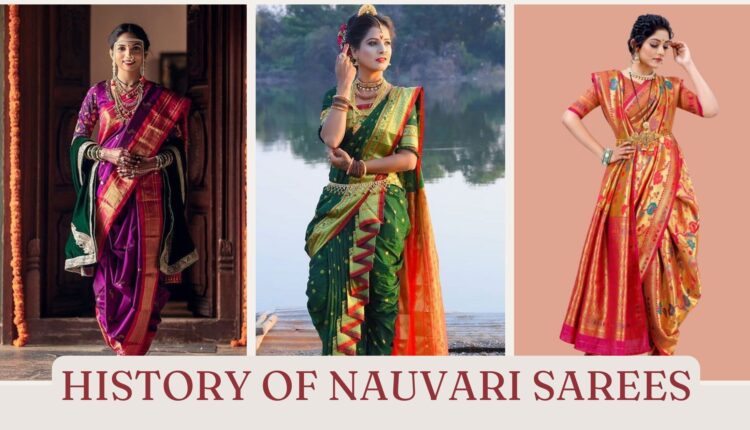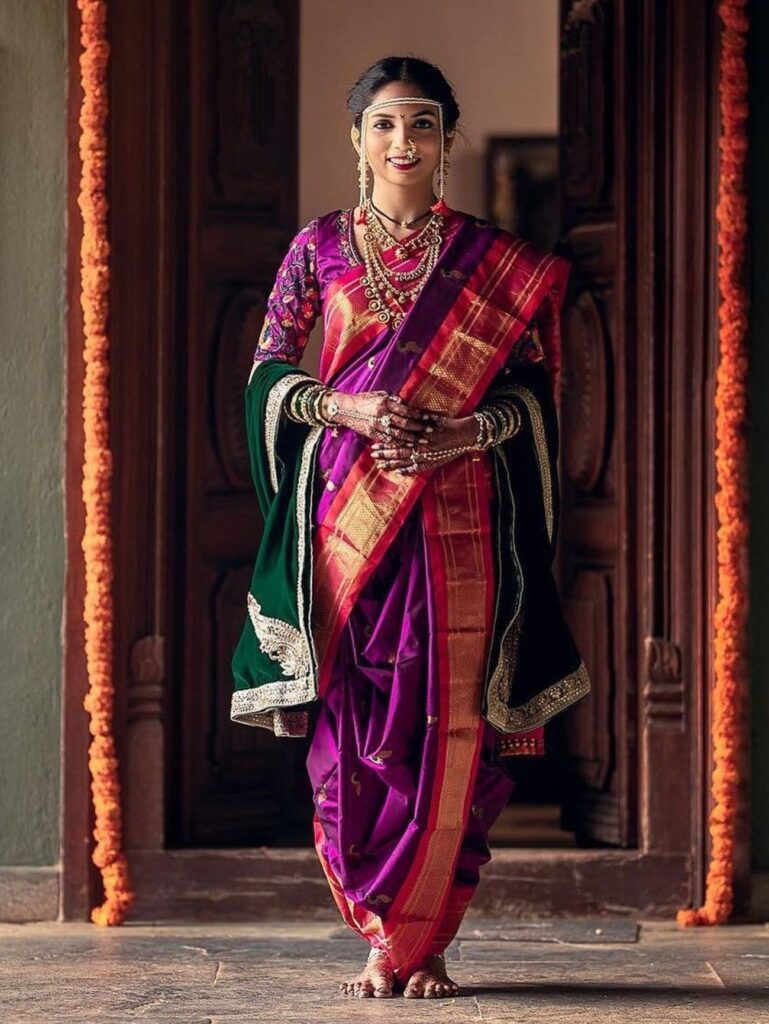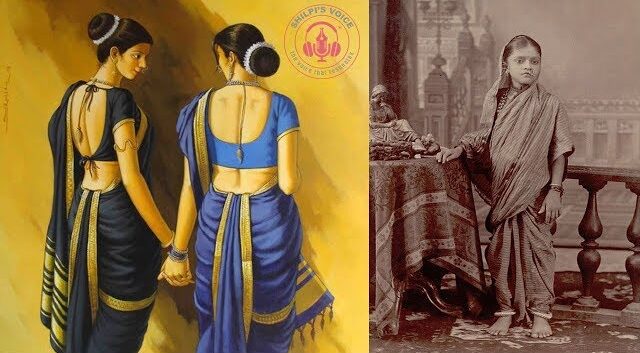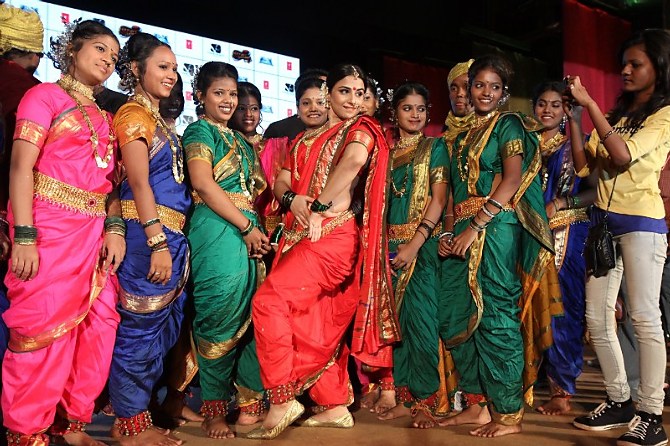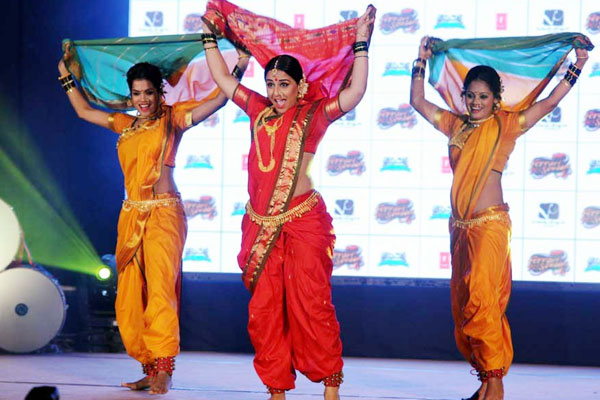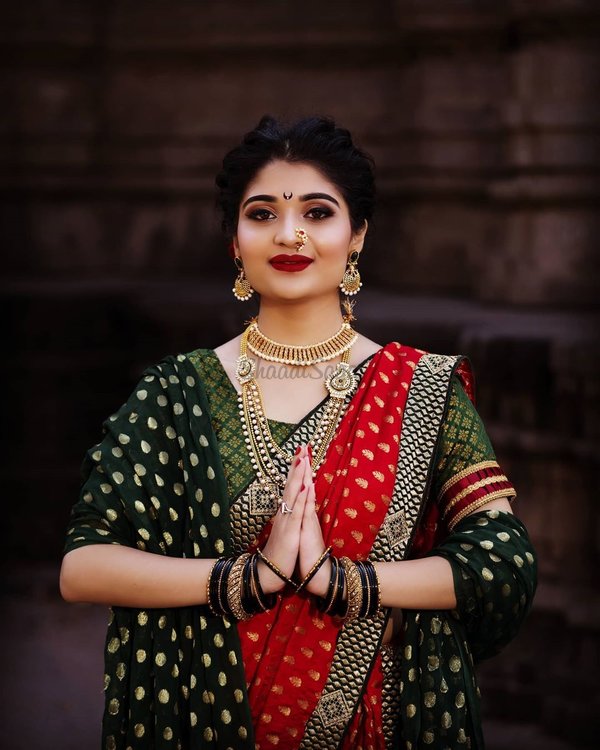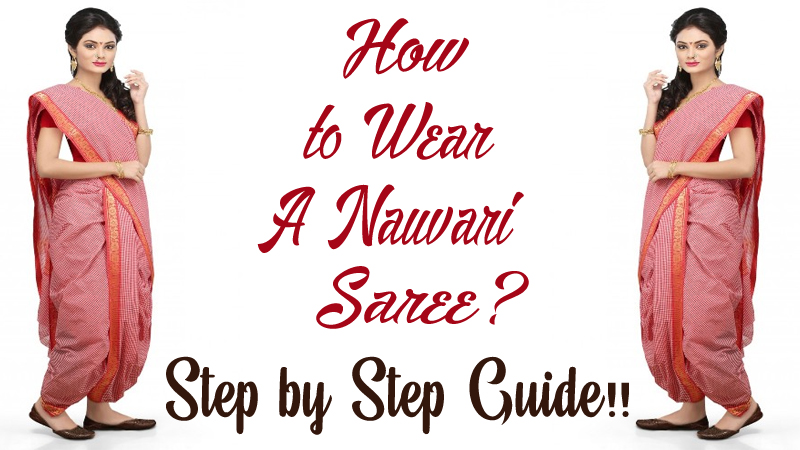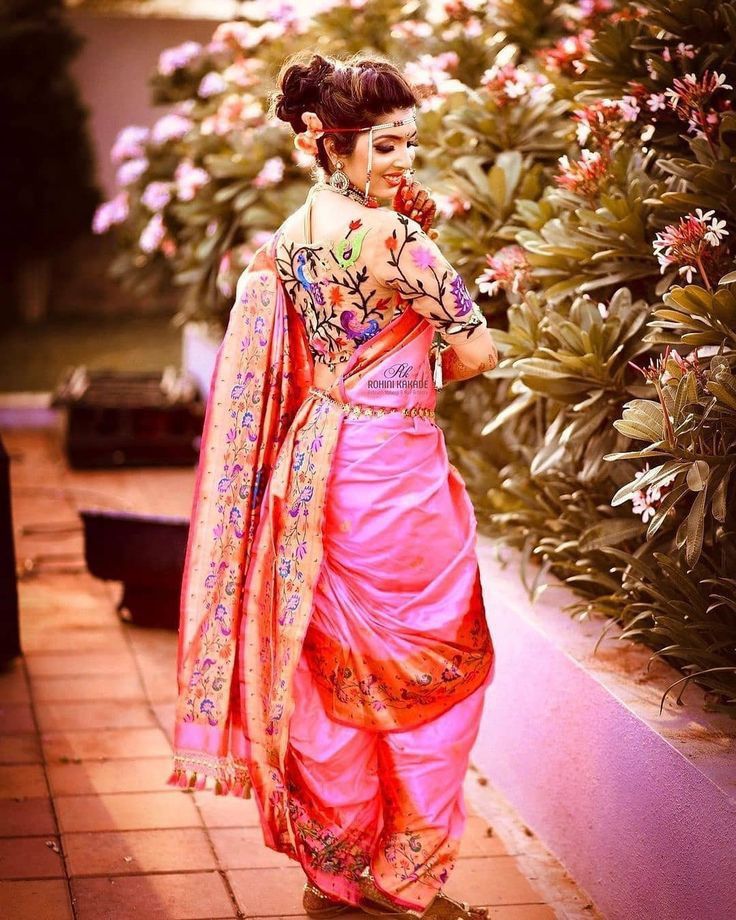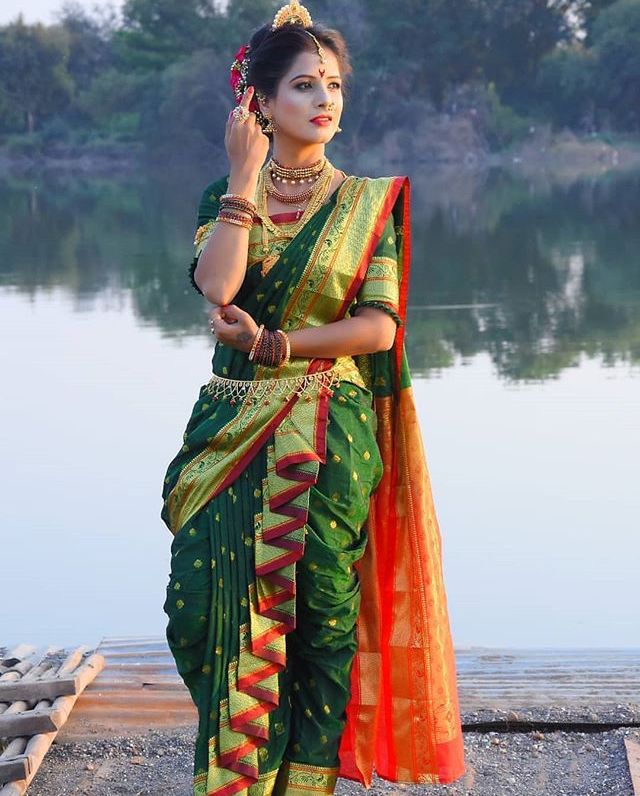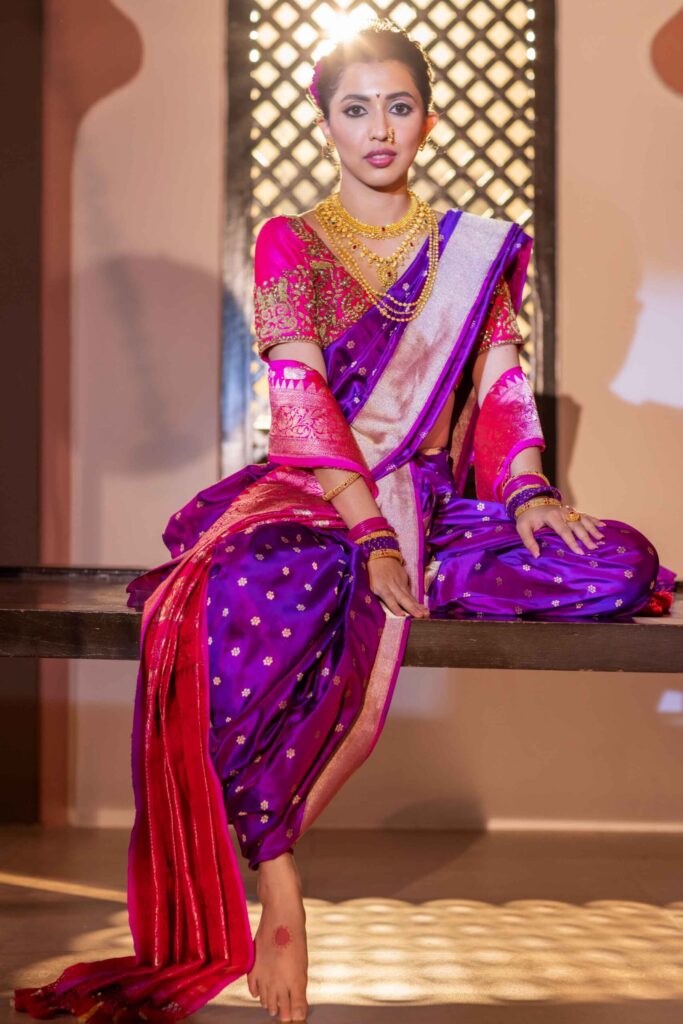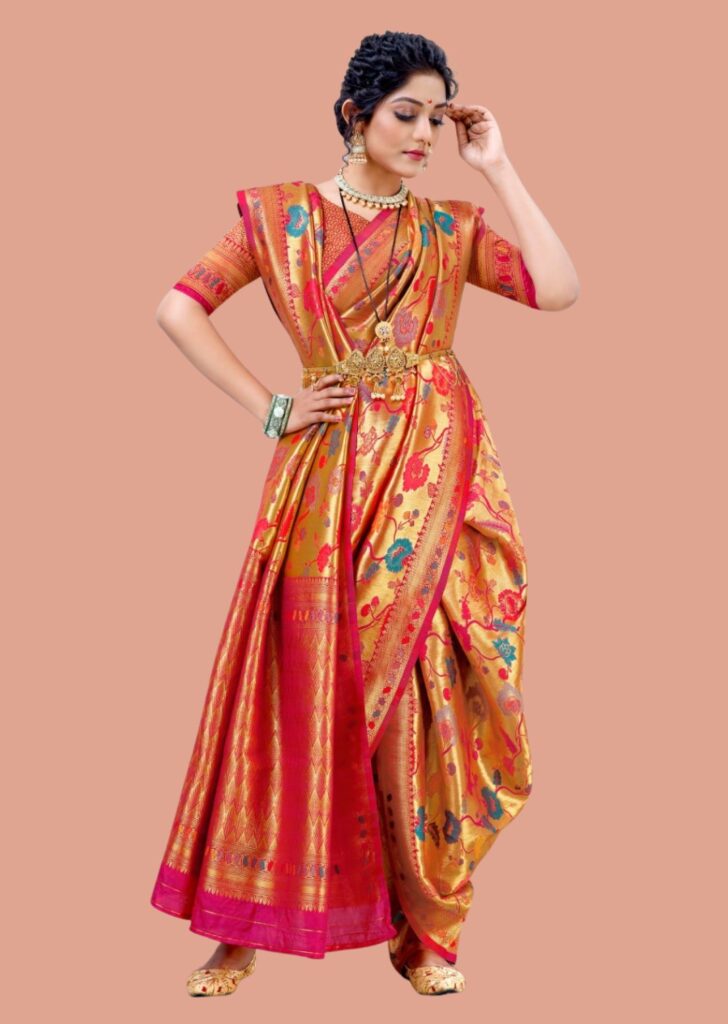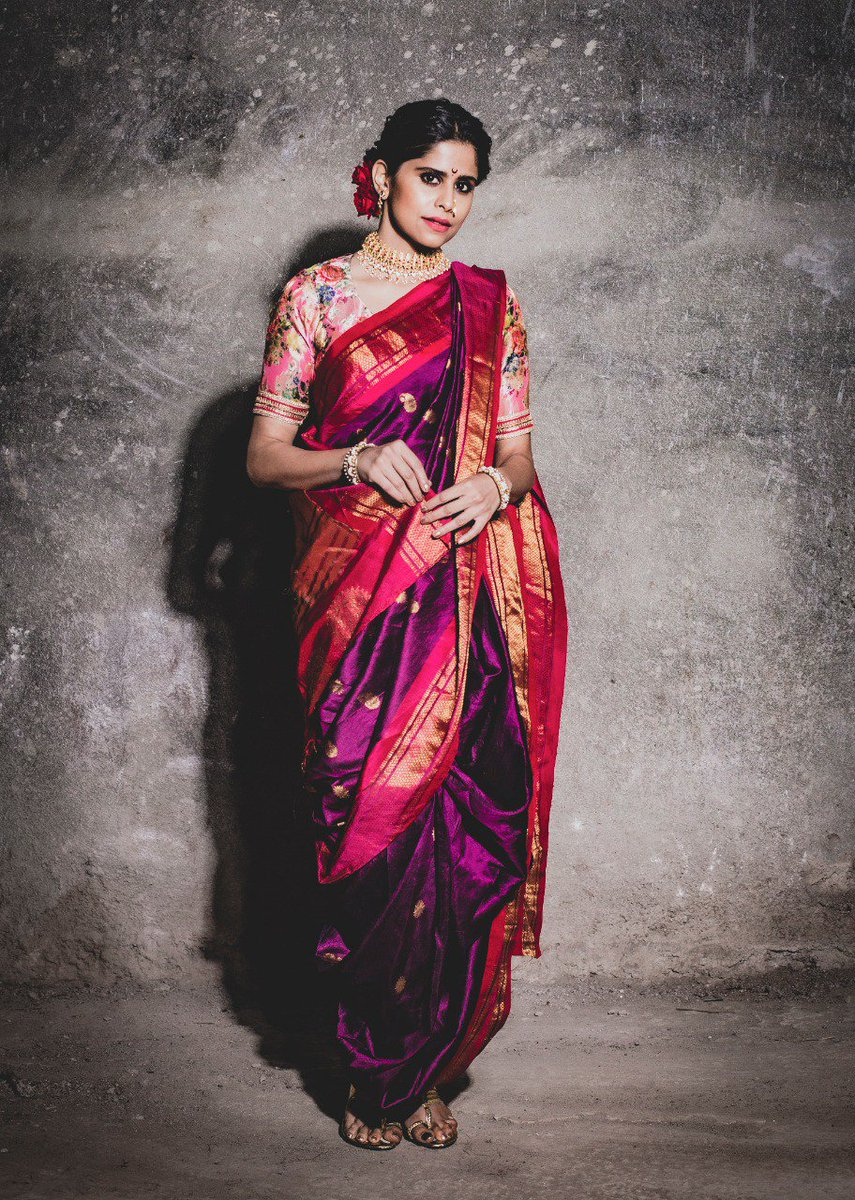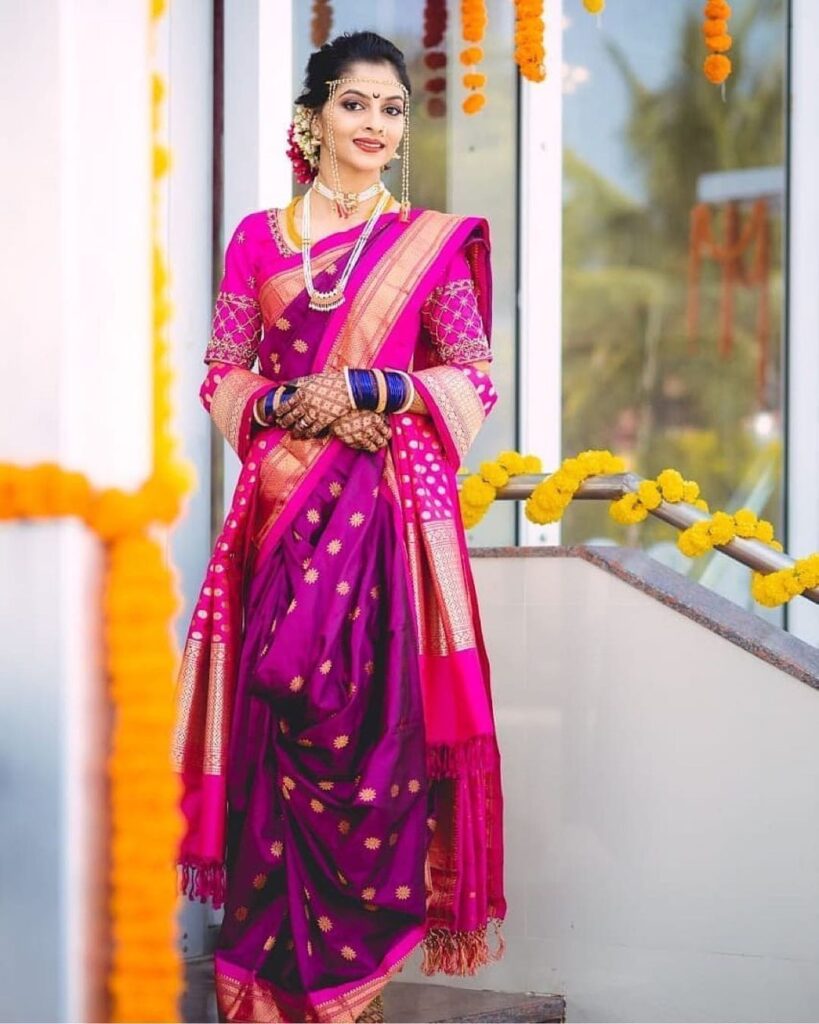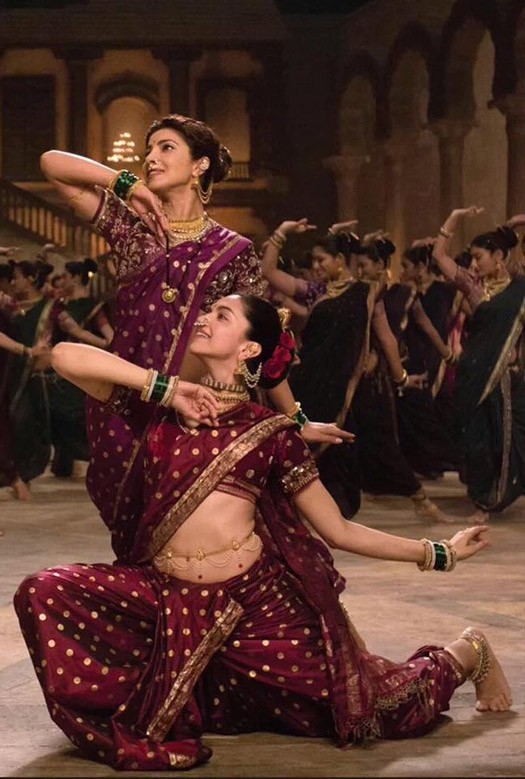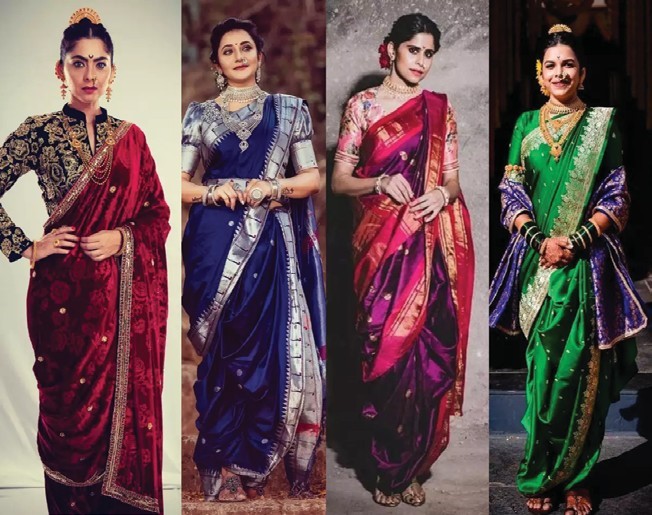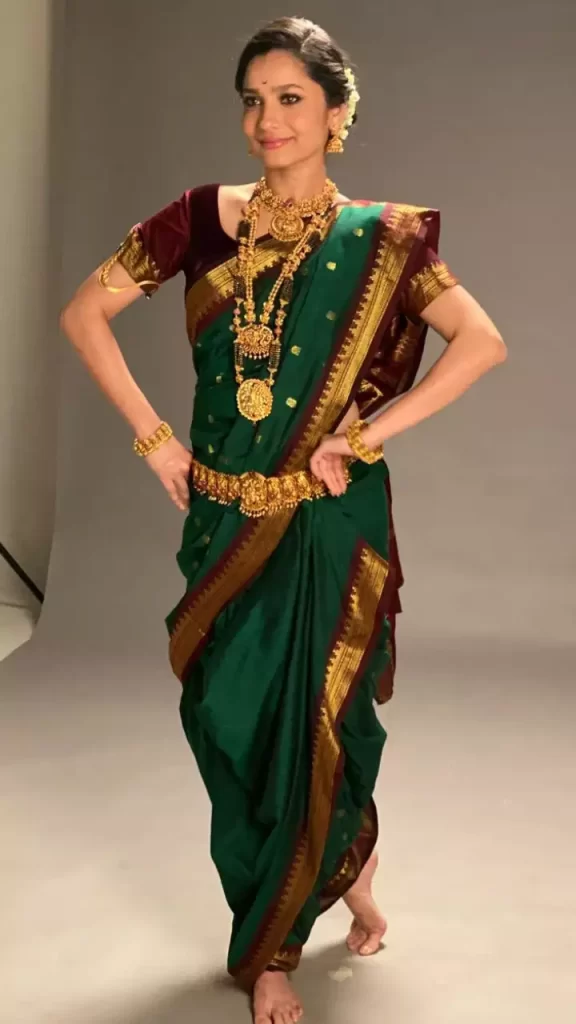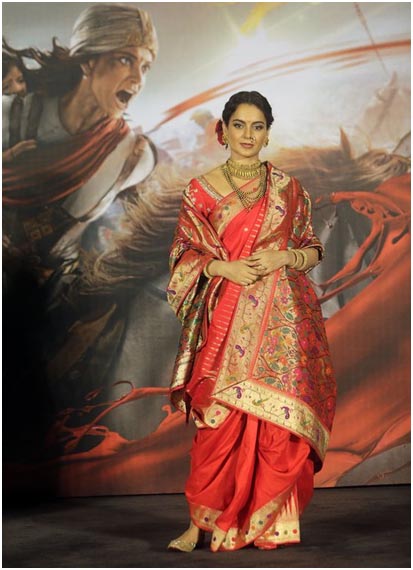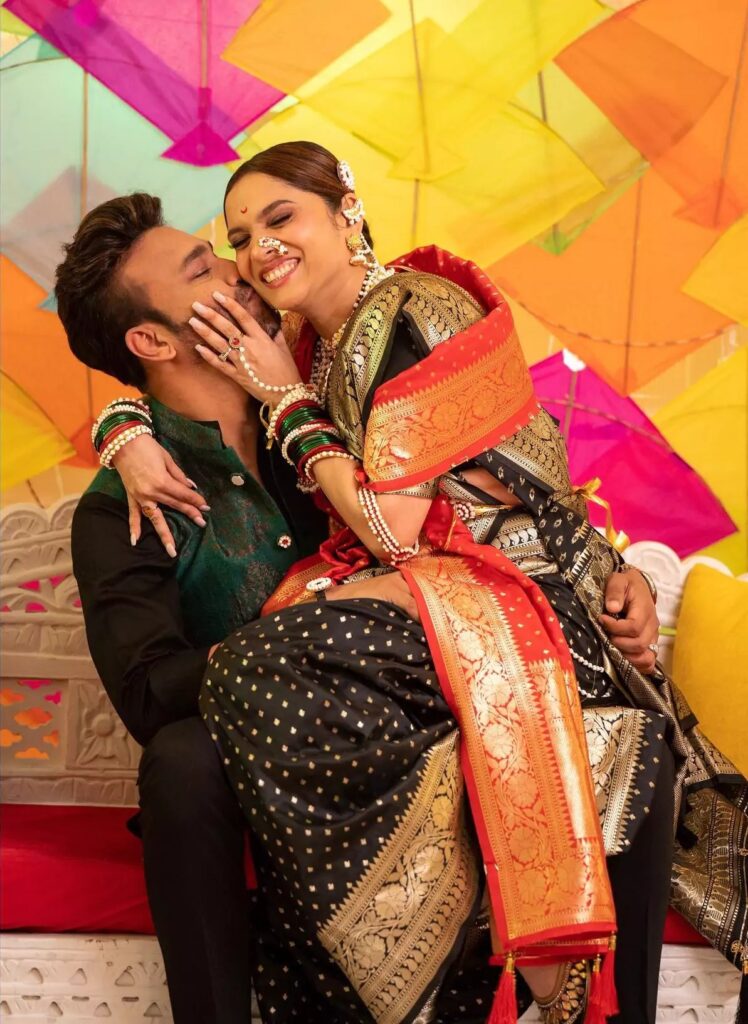Table of Contents
The Nauvari saree, also known as the ‘Kashta saree’ or ‘Lugda,’ is a traditional nine-yard garment worn by women in the Maharashtra region of India. Its history is deeply intertwined with the cultural heritage and rich traditions of this state. The name Nauvari means nine yards. The dress gets its name since it takes 9 yards long fabric to create and drape the saree perfectly. That is how it got its name.
Nauvari Saree Origin
The origins of the Nauvari saree can be traced back to ancient Maharashtra, with its roots in the classical attire worn by Marathi women. It is mentioned in historical texts and paintings, dating as far back as the 18th century.
Nauvari Saree Features:
One of the key identifying features of the Nauvari saree is its nine-yard length, which allows for intricate draping styles. It is typically worn without a petticoat and is known for its ability to provide ease of movement, making it well-suited for traditional folk dances like Lavani. Women earlier used it to work as soldiers on the battlefield alongside men. This dress has a rich history attached to it indeed.
Evolution in Design:
Over time, the Nauvari saree has undergone subtle changes in design and embellishments. While the core design of the saree remains the same, modern additions may include contemporary patterns, fabrics, and even fusion elements, appealing to a wider audience. This has been done to attract a more modern audience to this historic dress.
Cultural Significance of Nauvari Saree:
The Nauvari saree holds a lot of cultural significance in Maharashtra. It is donned during various celebrations, festivals, and religious ceremonies, signifying grace, tradition, and the brave spirit of Marathi women. The Nauvari saree is indeed a dress wrapped in cultural heritage and traditional value.
Influence on Performing Arts:
This distinctive saree has left a permanent mark on the performing arts of Maharashtra. It is the preferred attire for Lavani and Tamasha performers, enhancing their movements and adding to the visual appeal of their performances. Being as versatile as it is, the Nauvari saree has made its place in the entertainment industry too.
Modern Audience and Global Appeal:
In recent years, there has been a growth of interest in traditional attire across India, and the Nauvari saree is no exception. Its unique draping style and elegant looks have captured the attention of fashion enthusiasts worldwide, making it a sought-after choice for special occasions. You will read more about the global impact of this dress later in the article.
How To Wear Nauvari Saree
The Nauvari saree, with its nine-yard length and unique draping style, is an anthem of traditional Maharashtrian attire. This gorgeous garment, also known as the ‘Kashta saree,’ carries an immense cultural heritage. Learning to drape a Nauvari saree is not just a skill; it’s an ode to tradition and a celebration of feminine grace and acts as a source to admire true feminine beauty.
Materials you will need:
Before we begin, let’s understand and gather the essentials:
– A Nauvari saree (9 yards in length)
– A blouse that fits well
– A petticoat (you may leave this one out, it’s optional)
– Waist chain or Kamar bandh
– Safety pins
Step 1: Preparing the Base:
You can start by wearing a blouse and a petticoat. If you choose not to wear a petticoat, tuck the saree directly into the waistband of your blouse.
Secure the saree at the right waist with a safety pin, ensuring it’s snug. This will prevent any discomfort or the dress slipping, causinf uncomfortable situations.
Step 2: Creating Pleats:
Hold the loose end of the saree and start making pleats, approximately 5 to 7 inches wide. Make around 5 to 6 pleats. After that just make sure that all the pleats face right.
Tuck the pleats into the center of the waistband, ensuring they are even and neat. This will form the front structure.
Step 4: Wrapping Around:
After completing the previous steps, move the remaining length of the saree, drape it around your back to the front, and tuck it into the waistband on the left side. This forms the ‘nivi’ or ‘nivi-style’ drape.
Step 5: Adjusting the Pallu:
Now, take the free end of the saree (the pallu), bring it over your left shoulder from the back, and let it hang gracefully.
Step 6: Making the Final Adjustments:
Ensure the pleats are aligned, the saree is snug at the waist, and the pallu drapes elegantly over your left shoulder.
Step 7: Adding Finishing Touches:
Optional: Wear a waist chain or kamarbandh over the saree to add a traditional touch and keep the pleats secure.
Draping a Nauvari saree is a simple process that may seem difficult at first but you can master it with a bit of practice. With practice, you’ll find your own style and finesse in this age-old tradition. Embrace the grace and elegance of this attire as you step into the world of Maharashtrian tradition. It perfectly embodies the Marathi tradition and acts as a cultural heritage.
Types of Nauvari sarees, diverse options!
The Nauvari saree, also known as the Navvari saree, is an iconic traditional garment originating from the state of Maharashtra, India. Its name is derived from the Marathi words “nau” meaning nine and “vari” meaning yards, signifying its generous length. This saree is renowned for its distinctive draping style, which provides both grace and freedom of movement to the wearer. Over the years, various types of Nauvari sarees have evolved, each carrying its own unique charm and cultural significance.
Paithani Nauvari Saree
The Paithani Nauvari saree is perhaps the most celebrated among all types of Nauvari sarees. It hails from the town of Paithan in Maharashtra and is characterized by its opulent silk fabric and intricate zari work. Adorned with peacock and flower motifs, the Paithani Nauvari is a piece of artistry that often features a contrasting pallu. This saree is a symbol of Maharashtrian culture and is worn on special occasions like weddings and festivals.
Kashta Nauvari Saree
The Kashta Nauvari saree know for its rich, brocade-like appearance. It is made by interweaving silk or cotton threads to create a textured surface. The Kashta technique lends a luxurious feel to the fabric, making it a favored choice for formal events. It embellish with intricate borders and pallus, adding to its allure.
Banarasi Nauvari Saree
A blend of the exquisite Banarasi silk and the traditional Nauvari drape, the Banarasi Nauvari is a testament to India’s rich textile heritage. This saree is famous for its intricate gold and silver zari work, which adorns the fabric with motifs like flowers, leaves, and intricate patterns. Its lustrous appearance and regal feel make it a popular choice for bridal ensembles.
Kanjivaram Nauvari Saree
Originating from the town of Kanchipuram in Tamil Nadu, the Kanjivaram Nauvari famous for its thick silk and vibrant, contrasting borders. This saree characterize to its bold and striking designs, often featuring temple-inspired motifs. It is a testament to the craftsmanship and artistry of the weavers from the region.
Cotton Nauvari Saree
As the name suggests, the Cotton Nauvari craft from breathable cotton fabric, making it perfect for everyday wear. It know for its comfort and simplicity, making it a popular choice for casual and festive occasions. These sarees often feature minimalistic designs, with a focus on vibrant colors and comfortable draping.
Peshawari Nauvari saree
The Peshawari Nauvari Saree, originating from the culturally rich region of Peshawar, Pakistan, is a testament to the exquisite craftsmanship and heritage of the area. The fabric is typically rich silk, known for its luxurious feel and elegant drape.
Peshawari Nauvari sarees often feature elaborate patterns and motifs inspired by the natural beauty and architectural marvels of the area. They favor for grand celebrations, including weddings and festivals, where they grace the wearer with an air of regality and sophistication. The Peshawari Nauvari Saree not only embodies the artistry of its makers but also carries with it a piece of history, making it a cherished piece of traditional attire for women who appreciate both style and heritage.
Wedding Nauvari saree
The Wedding Nauvari Saree is a masterpiece of elegance and cultural significance, adorning brides on their special day in Maharashtra, India. Crafted with meticulous attention to detail, these sarees typically make from luxurious fabrics like silk or fine Banarasi, showcasing opulent embroidery, intricate zari work, and ornate embellishments. They boast a nine-yard length, allowing for graceful draping in the traditional Maharashtrian style, which symbolizes the strength and adaptability of a married woman.
The color palette of wedding Nauvari sarees ranges from rich reds, auspicious greens, to regal maroons, each carrying its own symbolic meaning. The pallu is often the focal point, adorned with elaborate designs and embellishments. These sarees exude a timeless charm, making them a treasured heirloom passed down through generations, carrying with them the essence of love, tradition, and matrimonial sanctity. The Wedding Nauvari Saree, with its grandeur and cultural importance, remains an integral part of Maharashtra’s rich bridal heritage.
A Rich History of Pochampally saree
Global impact of the Nauvari Saree
Today, Nauvari sarees are not confining to traditional ceremonies alone; they become a symbol of elegance, versatility, and cultural appreciation across the globe.
Cultural Exchange and Influence
In an era of cultural exchange, the Nauvari saree has found a place of prominence in international fashion. Designers from various corners of the world are drawing to its unique draping style, vibrant colors, and intricate patterns. This global fascination has led to innovative interpretations and fusion styles, where elements of Nauvari aesthetics are seamlessly blending with contemporary trends.
The Redefined Nauvari Aesthetic
Contemporary Nauvari sarees have undergone a transformation while preserving their traditional essence. Modern variants feature lighter fabrics, making them more wearable for a variety of occasions. Designers experiment with a wide range of textiles, including georgette, silk blends, and organza, giving rise to Nauvari sarees that are not only elegant but also comfortable.
Global Celebrities Embrace the Nauvari
The global appeal of Nauvari sarees is evident in their adoption by international celebrities. Renowned figures from the world of entertainment, fashion, and politics spots donning these graceful ensembles at red-carpet events, premieres, and cultural gatherings. This not only highlights the saree’s universal charm but also serves as a testament to its ability to transcend cultural boundaries.
Social Media and the Nauvari Trend
The power of social media platforms has played an important role in driving the Nauvari saree into the global spotlight. Fashion influencers and enthusiasts from around the world use platforms like Instagram, Pinterest, and YouTube to showcase their very own interpretations of this traditional attire. This online community has contributed greatly to the saree’s popularity among a diverse audience. It has created a network and it has reached the necessary audience needed to grow the dress from a national to a global phenomenon.
Preserving Tradition, Celebrating Diversity
While the Nauvari saree has found international demand, it also remains deeply connected In its heritage. Artists and craftsmen continue to create marvelous pieces using traditional techniques. It is ensuring that the essence of Maharashtra’s rich textile legacy continues and lives on. Additionally, the global embrace of the Nauvari saree showcases the beauty of cultural exchange and appreciation, reinforcing the idea that fashion knows no boundaries.
The Nauvari saree, with its rich history. And a large range of styles, stands as a representation of India’s cultural and textile heritage. Each type mentioned above carries its own unique aura, making it suitable for various occasions and events. Whether adorned with intricate zari work or woven with breathable cotton. The Nauvari saree continues to be a preferred attire for women across the country. It is representing a timeless fusion of tradition and elegance. This makes Nauvari sarees so special and versatile.
Related Search Terms:
history of nauvari saree
the name of an indian state where the women wear nauvari saree
nauvari saree history
how to wear nauvari saree
which state women wear nauvari saree
where women wear nauvari saree
importance of nauvari saree
name of an indian state where the women wear nauvari saree
nauvari saree pattern with name
nauvari saree design
nauvari meaning
nauvari types in marathi
women in nauvari saree
nauvari saree origin
Origins of the nauvari saree
Everything You Need to Know About nauvari saree
All You Need to Know About nauvari saree
A Brief History Of nauvari saree
History And Significance of nauvari saree


